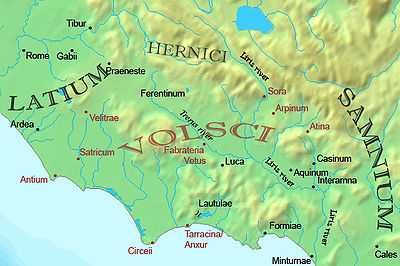Volsci

The Volsci were an Italic tribe, well known in the history of the first century of the Roman Republic. At that time they inhabited the partly hilly, partly marshy district of the south of Latium, bounded by the Aurunci and Samnites on the south, the Hernici on the east, and stretching roughly from Norba and Cora in the north to Antium in the south. Rivals of Rome for several hundred years, their territories were taken over by and assimilated into the growing Republic by 300BC.
Description by the ancient geographers
Strabo says that the Volsci formed a sovereign state near the site of Rome.[1] It was placed in the Pomentine plain, between the Latins and the Pontine marshes, which took their name from the plain.
Language
The Volsci spoke Volscian, a Sabellic Italic language, which was closely related to Oscan and Umbrian, and more distantly to Latin.
In the Volscian territory lay the little town of Velitrae (modern Velletri), home of the ancestors of Caesar Augustus. From this town comes an inscription dating probably from early in the 3rd century BC; it is cut upon a small bronze plate (now in the Naples Museum), which must have once been fixed to some votive object, and dedicated to the god Declunus (or the goddess Decluna).[citation needed]
Conflict with ancient Rome
The Volsci were among the most dangerous enemies of ancient Rome, and frequently allied with the Aequi, whereas their neighbours the Hernici from 486 BC onwards were the allies of Rome. [citation needed]
According to Rome's early semi-legendary history, Rome's seventh and last king Lucius Tarquinius Superbus was the first to go to war against the Volsci, commencing two centuries of a relationship of conflict between the two states. [2]
Also, the legendary Roman warrior Gaius Marcius Coriolanus earned his cognomen after taking the Volscian town of Corioli in 493 BC. The supposed rise and fall of this hero is chronicled in Shakespeare's Coriolanus.
However, if Livy's account of the war between Rome and Clusium is accurate, it can be seen that the relationship between Rome and the Volsci was not always hostile. Livy writes that, at the approach of the Clusian army in 508 BC, with the prospect of a siege, the Roman senate arranged for the purchase of grain from the Volsci to feed the lower classes of Rome.[3]
Notable Volscians
- This list is incomplete; you can help by expanding it.
- Attius Tullus
- Tullus Aufidius
- Cicero, orator and writer, was a native of Arpinum in former Volscian territory.
- Camilla featured as one of the fighters in Virgil's Aeneid, a Volscian Warrior Maiden (like the legendary Amazons). Virgil says that she can outrun the wind and run over crops so lightly she never even bent them. She could run over the waves of the sea without getting her feet wet. She fights on the side of the Latins and kills a lot of the Trojan refugees before being killed herself by the Etruscan Arruns. Source 'Virgil, his life and times' by Peter Levi, pub Duckworth, 1998
- Gaius Marius, reforming consul and general, was a native of Arpinum in former Volscian territory.
- Augustus Caesar spent his early life in Velitrae, where he may have been born.[citation needed]
References
Bibliography
 This article incorporates text from a publication now in the public domain: Chisholm, Hugh, ed. (1911). Encyclopædia Britannica (11th ed.). Cambridge University Press
This article incorporates text from a publication now in the public domain: Chisholm, Hugh, ed. (1911). Encyclopædia Britannica (11th ed.). Cambridge University Press